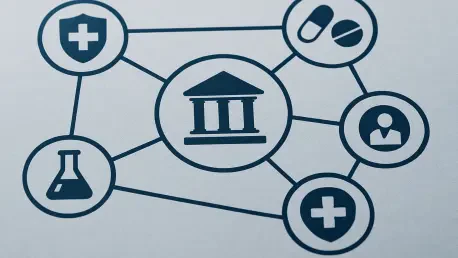Healthcare payer networks, the critical infrastructure supporting insurance companies, government entities, and private organizations in managing provider relationships and administrative tasks, stand at the threshold of a profound transformation. As the healthcare industry grapples with escalating complexity driven by rising costs, regulatory demands, and the urgent need for efficiency, these networks are poised to evolve dramatically over the next decade. Currently valued at USD 8.5 billion, the market for healthcare payer network management is projected to soar to USD 28.4 billion by 2035, achieving a robust compound annual growth rate (CAGR) of 12.8%. This remarkable growth signals not just an expansion in market size, but a fundamental shift in how payers operate, moving from outdated, manual processes to sophisticated, technology-driven systems. The pressure is mounting for payers to streamline operations, reduce errors, and ensure seamless interactions with providers, all while navigating a landscape increasingly shaped by digitization. This article delves into the forces propelling this evolution, from technological innovation to regional dynamics, exploring the challenges, opportunities, and key trends that will redefine healthcare payer networks by 2035. What lies ahead is a journey of adaptation and innovation, promising to reshape the very foundation of healthcare administration.
Market Expansion and Projected Growth
The healthcare payer network management market is on track for extraordinary growth over the next ten years, nearly tripling its value as it responds to global demands for better healthcare administration. Starting at a valuation of USD 8.5 billion in the current year, the market is expected to rise to USD 15.2 billion by 2030, adding a substantial USD 6.7 billion in just five years. This initial surge is largely fueled by a pressing need to transition from legacy systems to modern digital platforms, as payers across the globe prioritize automation and efficiency to keep pace with an increasingly complex industry. The rapid adoption of these technologies during this phase highlights a critical turning point, setting the stage for deeper transformations in the years that follow.
Looking further ahead, the growth trajectory steepens between 2030 and 2035, with the market projected to add another USD 13.2 billion, reaching a staggering USD 28.4 billion by the end of the forecast period. This accelerated expansion reflects a focus on integrating payer networks with electronic health records (EHRs) and adopting comprehensive management platforms that can handle diverse healthcare infrastructures. The consistent CAGR of 12.8% underscores a sustained appetite for solutions that not only enhance operational efficiency but also drive down costs. This isn’t merely a financial trend; it represents a systemic overhaul where fully automated systems become the norm, fundamentally altering how healthcare payers manage their networks and interact with providers by 2035.
Forces Driving Network Evolution
Several pivotal forces are steering the transformation of healthcare payer networks, with digitization leading the charge as a global imperative. Across both developed and emerging markets, payers are increasingly turning to automated systems to eradicate manual errors and streamline critical processes such as claims processing and provider credentialing. This shift toward digital solutions is not just about keeping up with technological trends but is a strategic move to enhance consistency in network administration. By adopting platforms powered by artificial intelligence (AI) and cloud-based technologies, payers can manage vast provider networks with unprecedented accuracy, fundamentally reshaping the operational landscape over the next decade.
Beyond digitization, the pursuit of administrative efficiency stands as a cornerstone of this evolution, driven by the relentless rise in healthcare costs. Payers are under immense pressure to minimize overhead expenses while maintaining high-quality service delivery, making advanced network management tools indispensable. These digital platforms, once considered optional, are now becoming mission-critical infrastructure, enabling payers to handle complex tasks with greater speed and precision. This focus on cost reduction and operational excellence is evident across public and private sectors alike, positioning technology as the linchpin for sustainable growth in an industry facing constant financial scrutiny.
Another significant driver is the worldwide push for healthcare infrastructure modernization, which is creating fertile ground for network transformation. In developed regions, established systems are being upgraded with cutting-edge tools to support operational flexibility, while emerging economies are building new frameworks from the ground up. Government-backed initiatives and modernization programs are amplifying this trend, ensuring a steady demand for solutions that improve service quality and administrative coherence. As healthcare systems globally strive for integration and scalability, the role of advanced payer networks becomes ever more critical, promising a future where seamless provider interactions are the standard by 2035.
Challenges Hindering Progress
Despite the promising outlook, the transformation of healthcare payer networks faces significant hurdles that could slow the pace of change. One of the most pressing obstacles is the high capital investment required to implement advanced systems, particularly in regions with constrained healthcare budgets. For many payers, especially in emerging markets, the upfront costs of adopting cutting-edge technologies can be prohibitive, delaying the transition from outdated processes to modern, automated platforms. This financial barrier risks widening the gap between well-funded and underfunded healthcare systems, creating disparities in the speed and scope of network evolution over the next decade.
Technical challenges also pose substantial barriers to progress, as integrating new digital solutions with existing legacy systems often proves complex and time-consuming. Many payers still rely on non-standardized formats or older equipment that struggles to align with modern platforms, leading to compatibility issues that hinder adoption. Additionally, market fragmentation—caused by varying healthcare standards and operational requirements across regions—further complicates the deployment of uniform solutions. These technical and structural limitations highlight the need for tailored approaches to implementation, ensuring that the benefits of advanced payer networks can be realized across diverse environments by 2035.
Segmental Insights and Market Structure
Diving into the market’s composition by component, software emerges as the dominant player, commanding a 60% share due to its robust capabilities in network optimization and automated provider credentialing. These solutions offer payers a comprehensive toolkit for managing intricate administrative tasks, integrating seamlessly with broader healthcare information systems. Their cost-effectiveness and high processing power make them a preferred choice for organizations looking to modernize quickly, ensuring that software remains at the forefront of market growth. As payers increasingly prioritize efficiency, the reliance on these advanced tools is expected to deepen, shaping the trajectory of network management through 2035.
In contrast, the services segment, though smaller in share, plays a vital role in facilitating the adoption of complex systems, with a projected revenue pool of USD 6.4-9.6 billion over the forecast period. This segment encompasses professional support, consulting, and multi-site deployment assistance, addressing the practical challenges of implementing new technologies across varied healthcare settings. As payers grapple with the intricacies of transitioning to digital platforms, the demand for such services grows, ensuring that technical expertise and tailored guidance are readily available. This complementary role underscores the importance of a balanced market structure, where both software and services contribute to a holistic transformation.
When analyzed by payer type, public payers hold the largest share at 55%, driven by their widespread use in government healthcare programs like Medicare. Supported by substantial budgets and modernization initiatives, these systems prioritize reliability and regulatory compliance, creating a revenue opportunity of USD 14.8-17.4 billion by 2035. Meanwhile, private payers, though secondary in market share, represent a high-growth area, particularly in specialized insurance and cloud-based applications, with potential revenues of USD 8.5-12.1 billion. Their agility in adopting innovative solutions positions them as a dynamic force, complementing the scale and stability of public payer systems in driving overall market expansion.
Deployment Trends and Preferences
Examining deployment modes reveals a clear trend toward cloud-based solutions, which are gaining momentum due to their scalability, flexibility, and ability to support remote operations. Particularly in developed markets, where digital infrastructure is robust, cloud platforms enable payers to manage networks efficiently across geographically dispersed locations. This shift aligns with broader healthcare digitization efforts, allowing for real-time data access and seamless integration with other systems. As the need for adaptability grows, cloud-based deployments are expected to dominate the landscape, offering payers a future-proof solution that can evolve with technological advancements through 2035.
On-premises solutions, while still relevant, are seeing slower growth compared to their cloud counterparts, as they cater to environments where strict data control and customization are paramount. Certain payers, particularly those handling sensitive information or operating under rigid regulatory frameworks, prefer the security and tailored nature of on-premises systems. However, their limited scalability and higher maintenance costs pose challenges in a rapidly digitizing industry. Despite these drawbacks, on-premises deployments maintain a niche but critical role, ensuring that diverse payer needs are met as the market progresses toward a more connected and automated future over the next decade.
Regional Variations and Growth Hotspots
Geographically, North America stands as the undisputed leader in healthcare payer network transformation, with the United States driving a 14.5% CAGR through aggressive digitization programs. A remarkable 91% deployment rate in insurance and government administrative sectors underscores the region’s commitment to modernizing healthcare administration, particularly in key hubs like California, Texas, and New York. This dominance is supported by robust infrastructure and substantial investments in technology, positioning North America as the epicenter of innovation. As these trends continue, the region is set to play a pivotal role in shaping global standards for payer networks by 2035.
Europe follows as a strong contender, with the market projected to grow from USD 2.1 billion currently to USD 6.8 billion by 2035, driven by countries like Germany (14.1% CAGR) and the U.K. (13.7% CAGR). These nations benefit from advanced healthcare technology sectors and stringent regulatory frameworks that encourage the adoption of compliant systems. Meanwhile, Asia Pacific shows significant promise, with Japan (13.3% CAGR) and South Korea (12.9% CAGR) leading through modernization efforts and high-quality system integration. Emerging markets in Latin America and the Middle East & Africa, though slower to adopt, hold untapped potential as healthcare budgets expand, setting the stage for accelerated growth in the latter half of the forecast period.
Competitive Dynamics and Key Players
The competitive landscape of healthcare payer network management is moderately concentrated, with 20-25 major players controlling approximately 65-70% of the global market share. Industry giants such as Optum Inc., Anthem Inc., and Humana Inc. maintain dominance by offering comprehensive solutions that emphasize advanced management capabilities and seamless integration with healthcare platforms. Their focus on reliability and precision creates high customer switching costs, allowing for premium pricing and sustained market leadership. These established players set a high benchmark, driving innovation and shaping industry standards as the market evolves toward 2035.
Challengers like McKesson Corporation and Change Healthcare are carving out significant space by focusing on specialized, flexible solutions that appeal to payers seeking tailored approaches. These technology innovators compete not through price wars but by offering unique interfaces and advanced administrative features that cater to specific needs. Additionally, regional specialists and emerging players contribute to the dynamic environment by targeting niche markets with cost-effective platforms, while traditional healthcare equipment contractors entering the space add further competitive pressure. This blend of established leaders and agile newcomers ensures a vibrant, innovation-driven market over the coming decade.
Pathways for Future Opportunities
Significant growth opportunities lie in software solutions, which hold a 60% market share and offer a revenue potential of USD 16.2-18.8 billion over the forecast period. Their strength in network optimization, automated credentialing, and integration with broader healthcare systems makes them a cornerstone of payer transformation. As payers increasingly rely on these tools to drive efficiency and reduce operational bottlenecks, software providers are well-positioned to capitalize on sustained demand. This segment’s dominance highlights a clear pathway for market participants to focus on developing scalable, feature-rich platforms that address evolving industry needs by 2035.
Public payer applications present another substantial opportunity, with a 55% market share and a revenue potential of USD 14.8-17.4 billion, driven by government-backed healthcare programs worldwide. Their emphasis on reliability, compliance, and integration with existing infrastructure ensures long-term demand, particularly in regions with strong public health initiatives. Meanwhile, cloud-based and private payer solutions offer a combined potential of USD 8.5-12.1 billion, catering to the growing need for flexibility and scalability. Additionally, AI and automation integration, valued at USD 7.2-10.8 billion, promises smarter systems with predictive capabilities, while services and compliance solutions round out key growth avenues, reflecting the diverse pathways available for market expansion.
Shaping the Future of Healthcare Administration
Reflecting on the past decade of analysis, the journey of healthcare payer networks has been marked by a relentless drive toward digitization, with early adopters paving the way for widespread adoption of automated systems. The market’s growth from a starting point of USD 8.5 billion to a projected USD 28.4 billion by 2035 stands as a testament to the industry’s commitment to efficiency and modernization. Challenges like high investment costs and technical integration issues have been persistent, yet the determination to overcome them through innovation remains strong.
Looking ahead, the next steps for stakeholders involve prioritizing scalable, cost-effective solutions that can adapt to diverse payer needs while maintaining high standards of reliability. Investment in AI and cloud technologies should be accelerated to unlock smarter, more predictive systems, ensuring networks are future-proof. Collaboration between public and private sectors can bridge financial and technical gaps, particularly in emerging markets. By focusing on these actionable strategies, the healthcare payer network landscape can continue to evolve, delivering a more connected, efficient, and responsive healthcare ecosystem for all by 2035.









